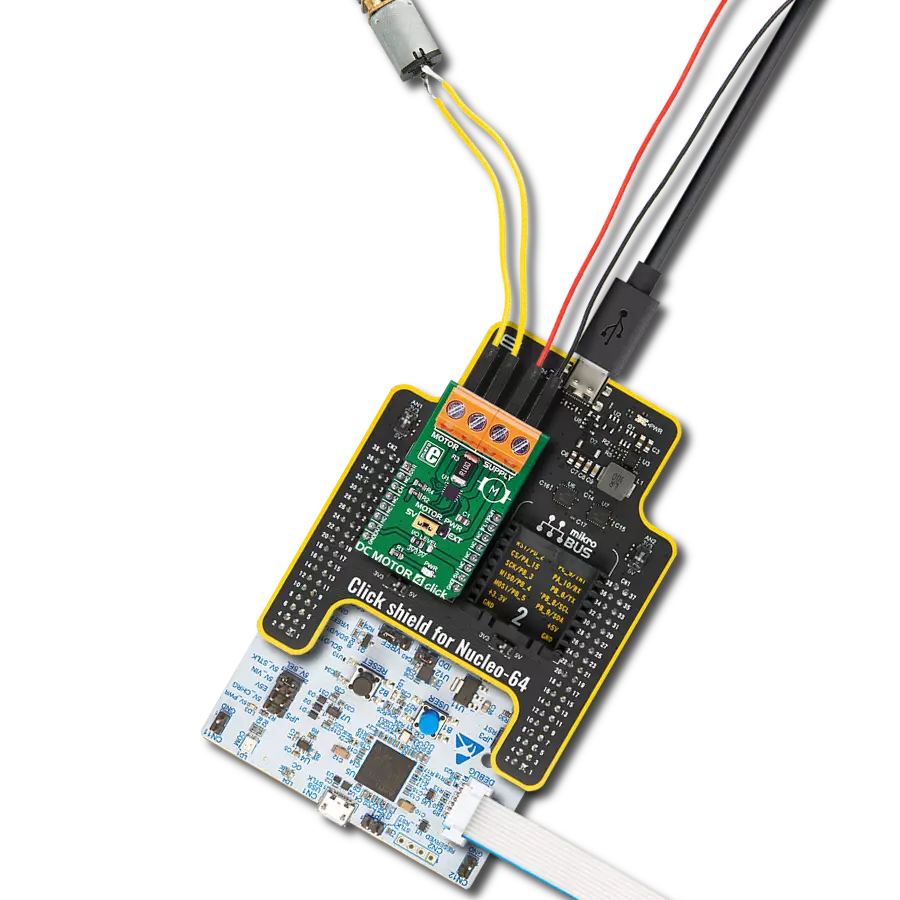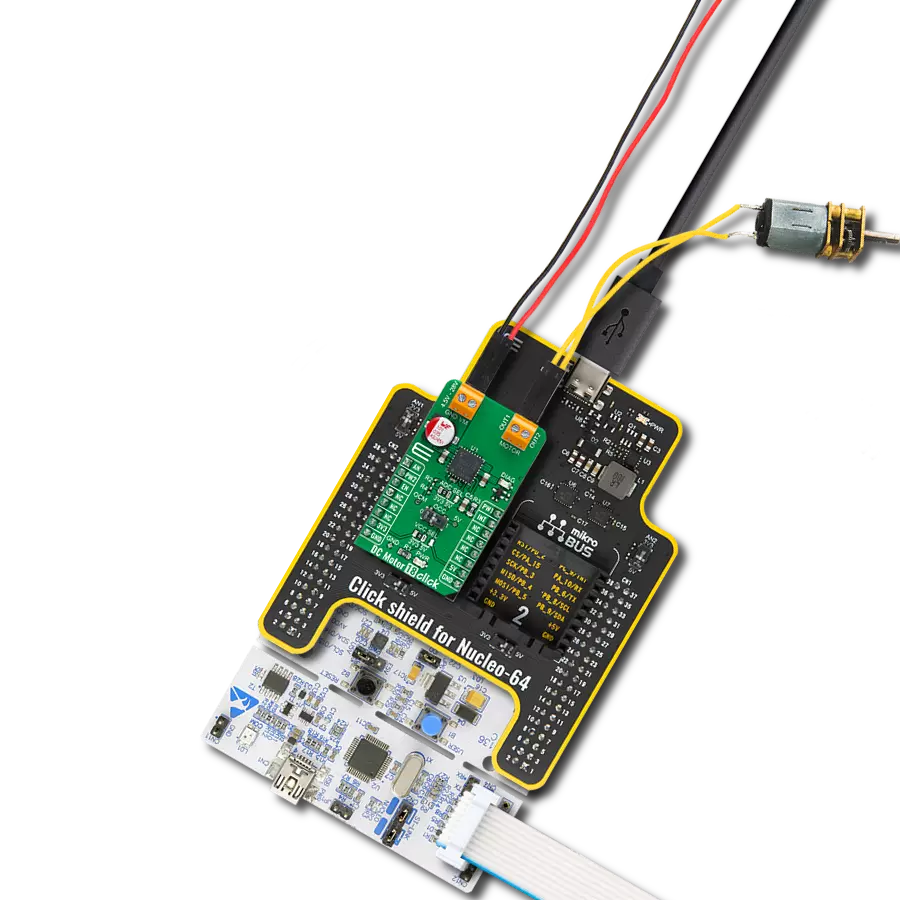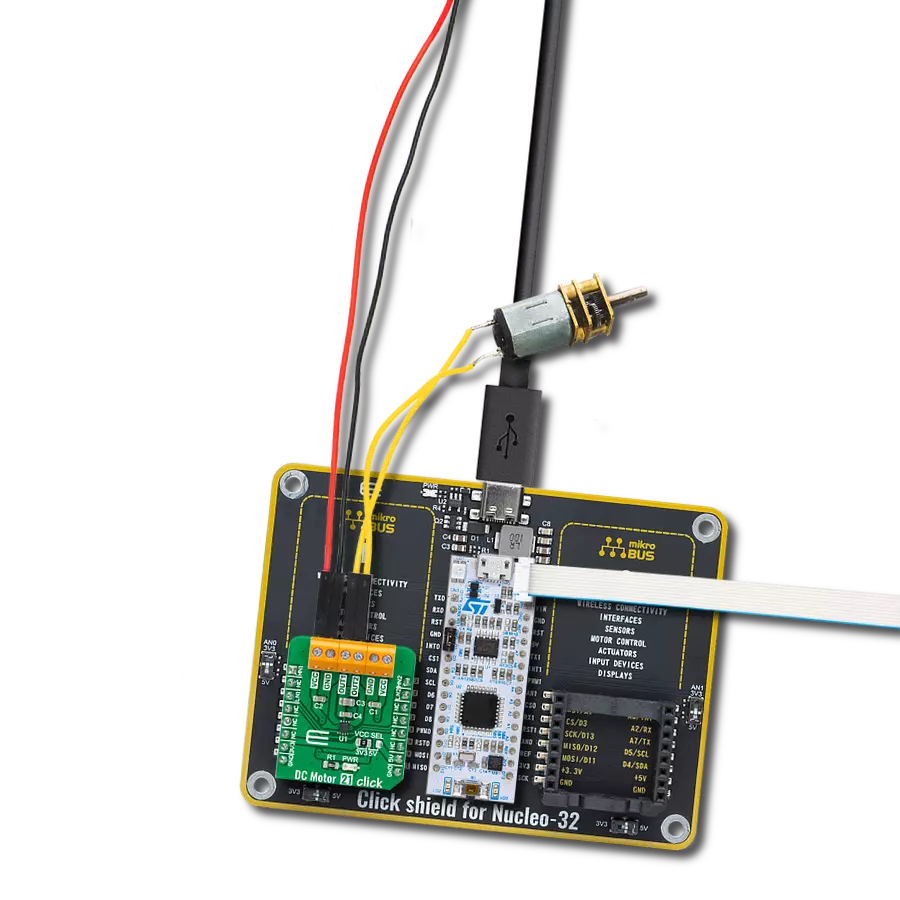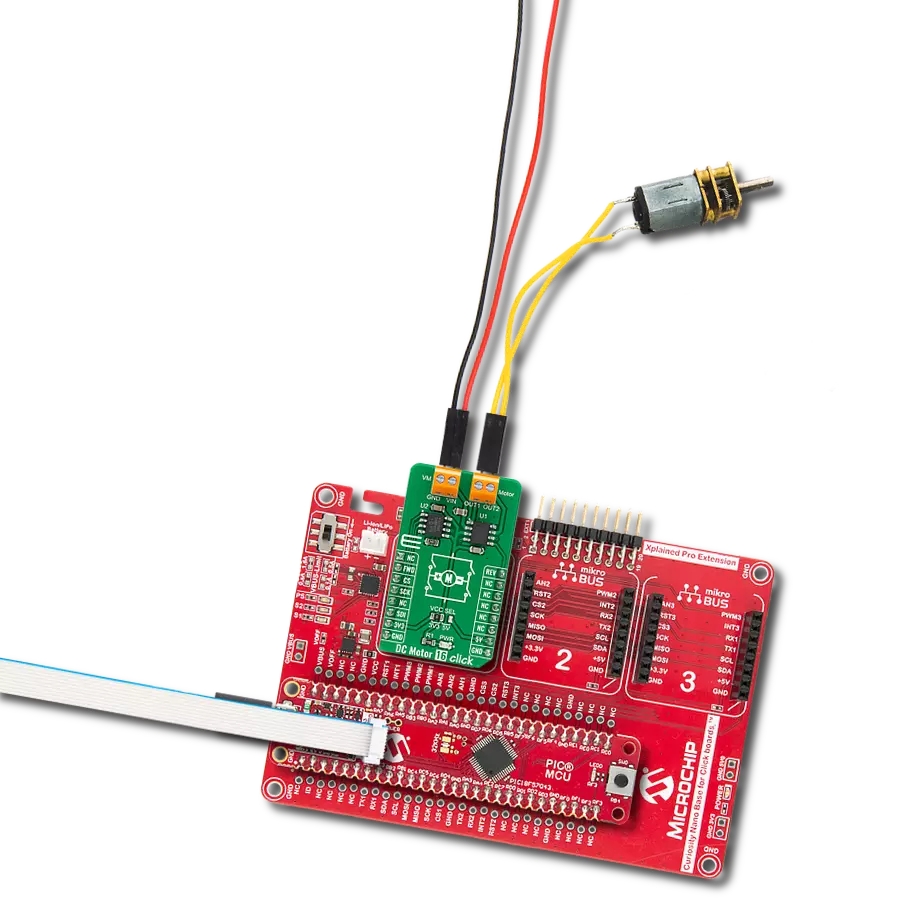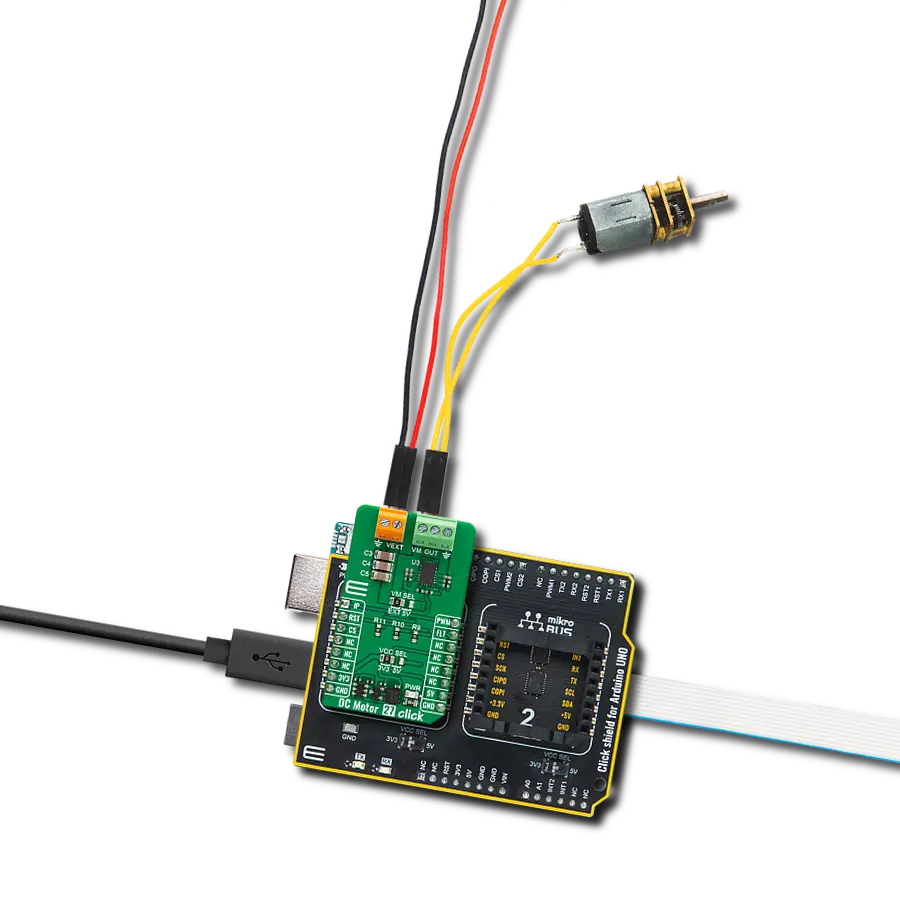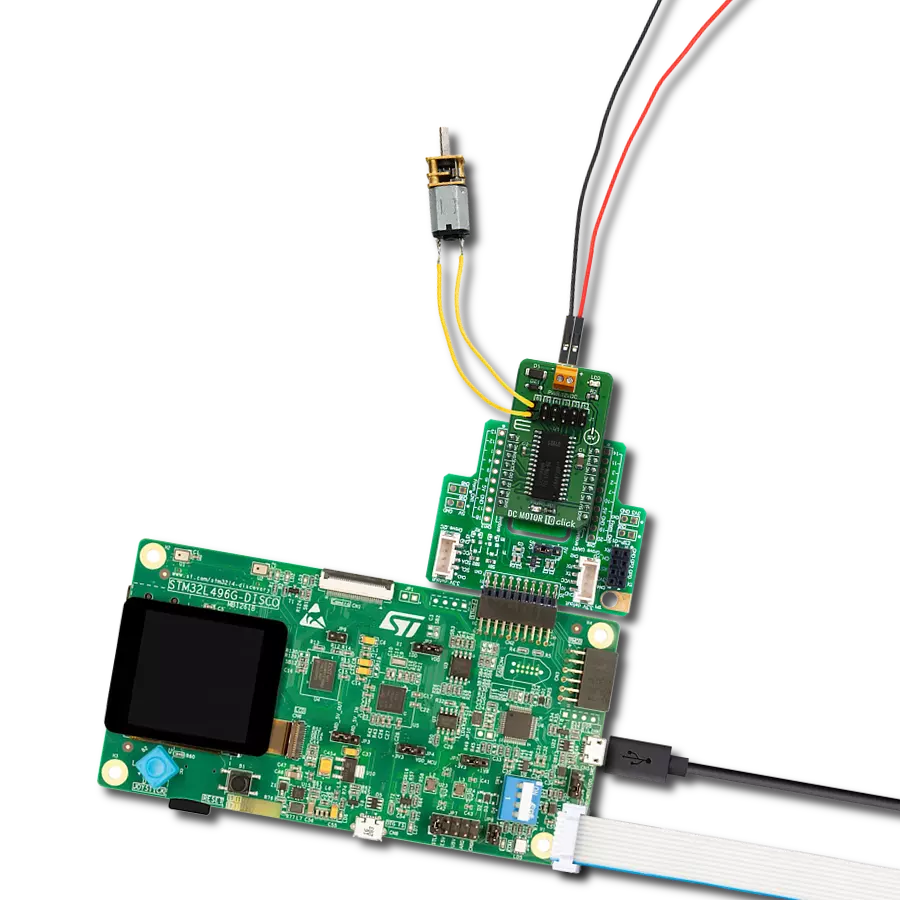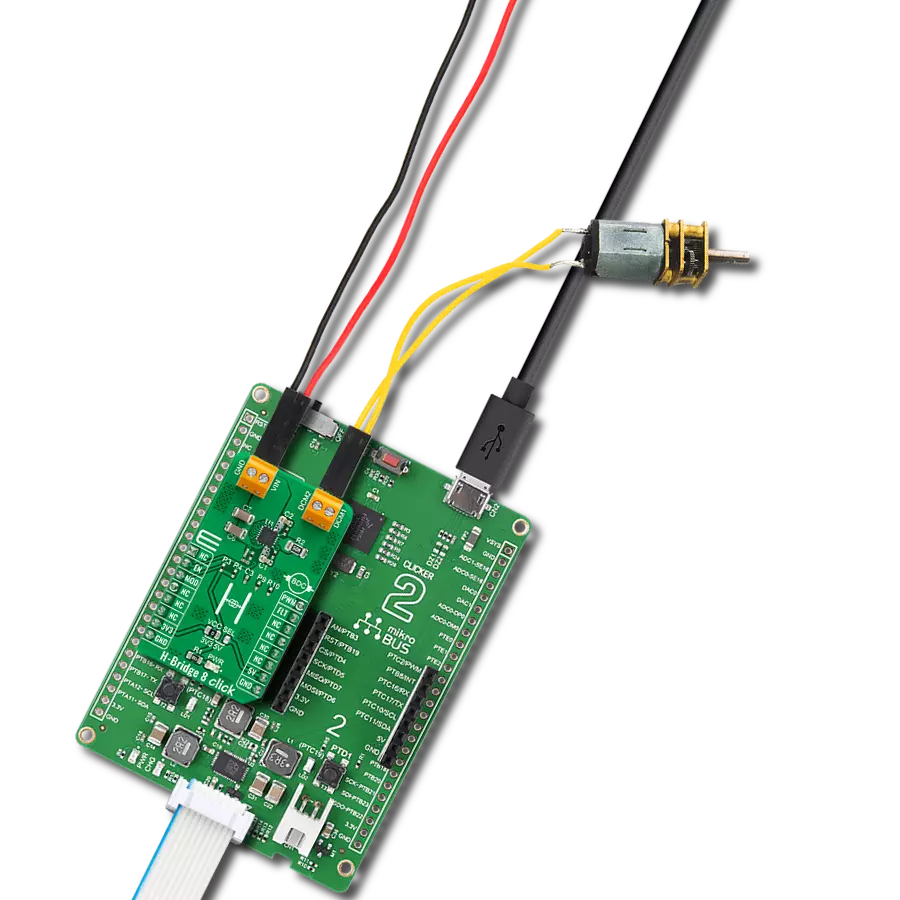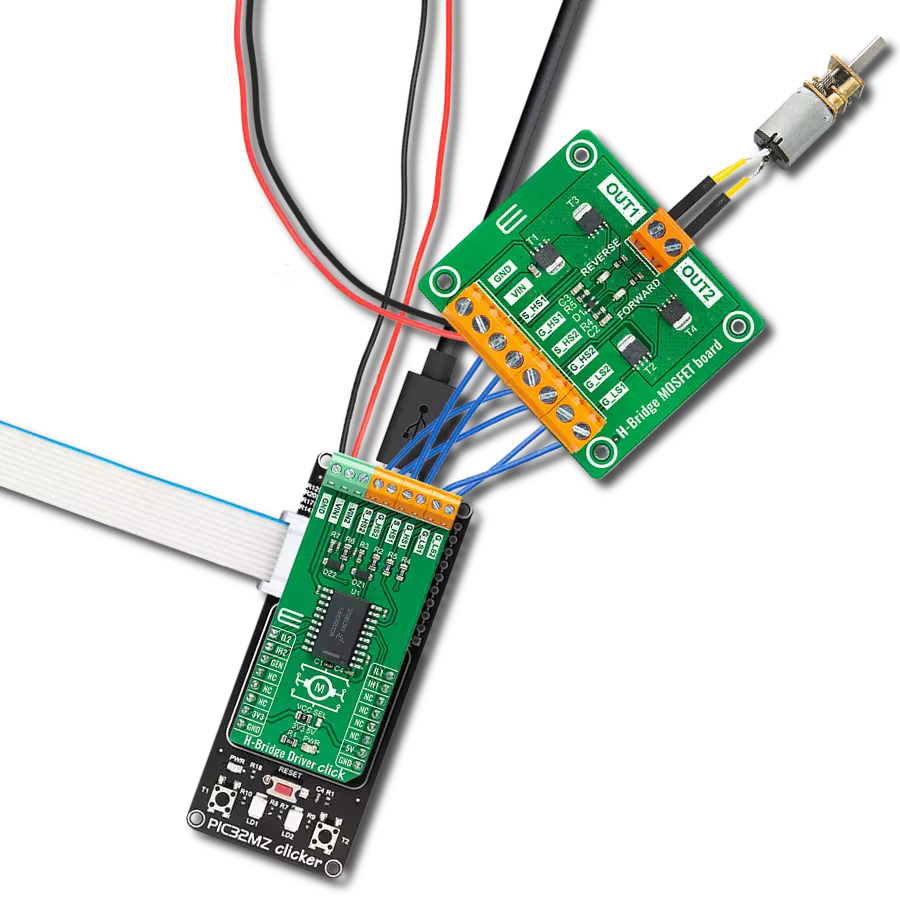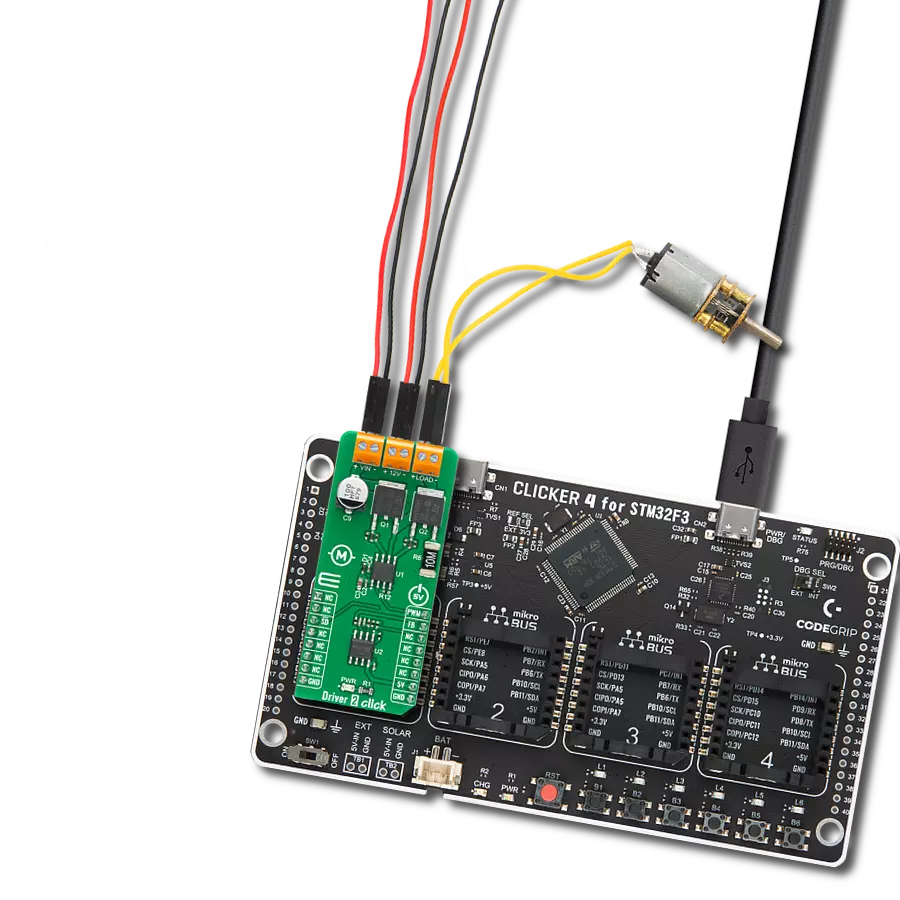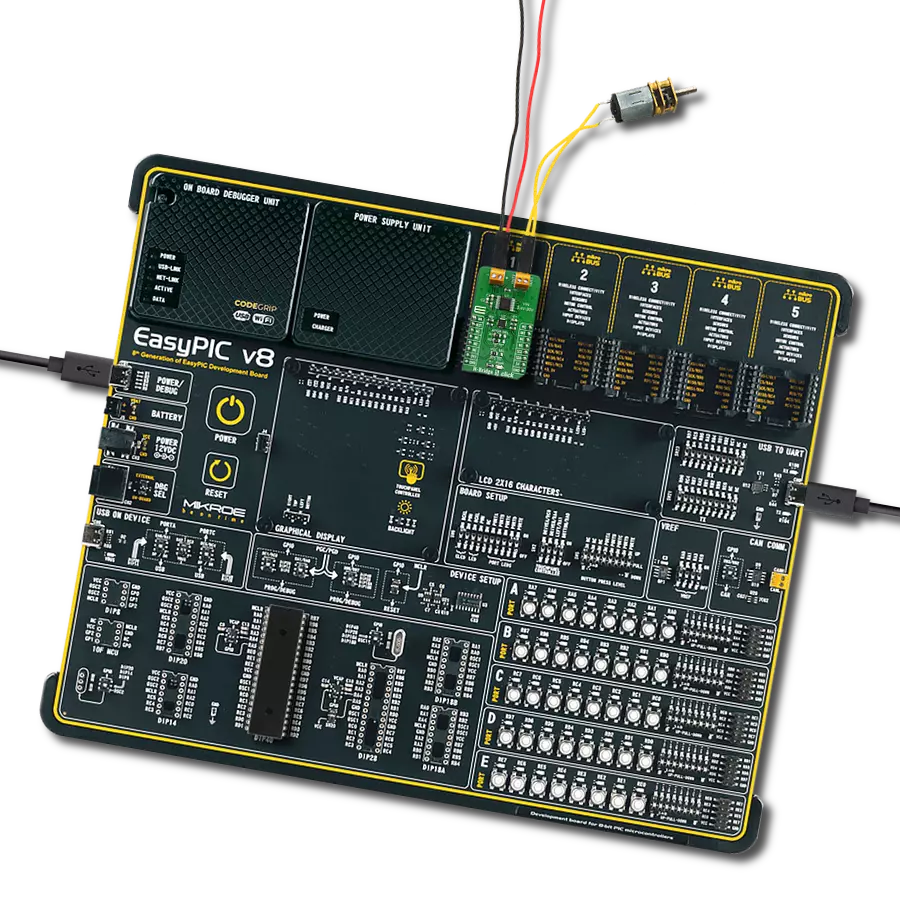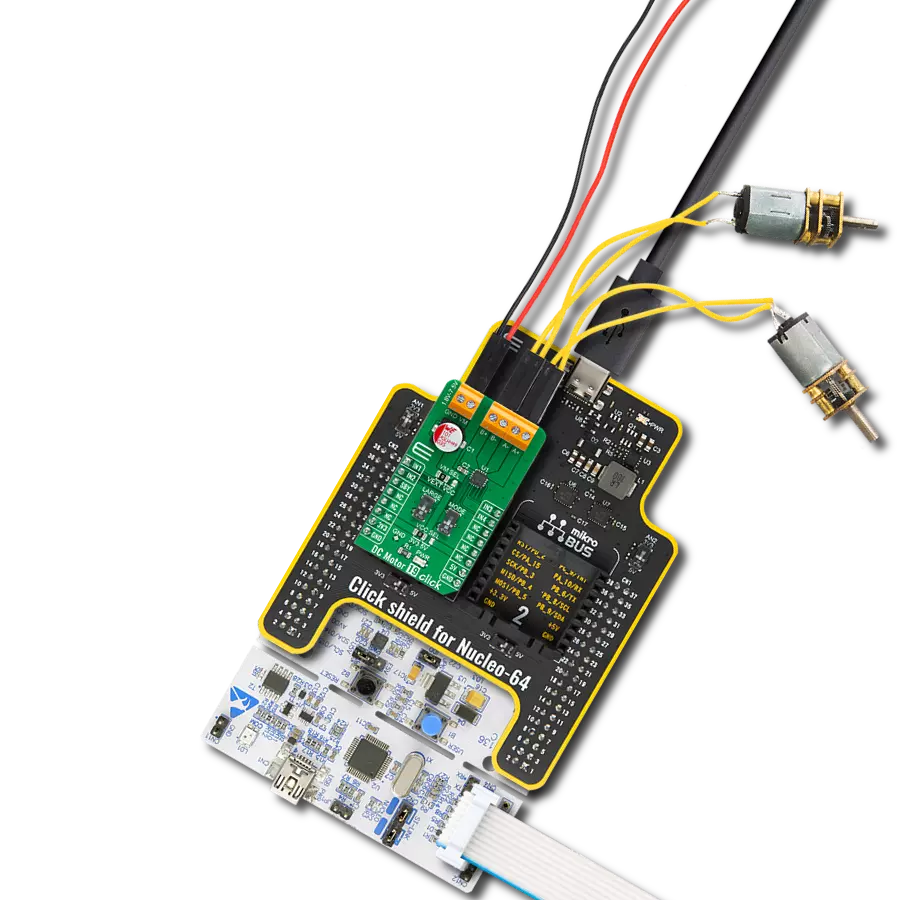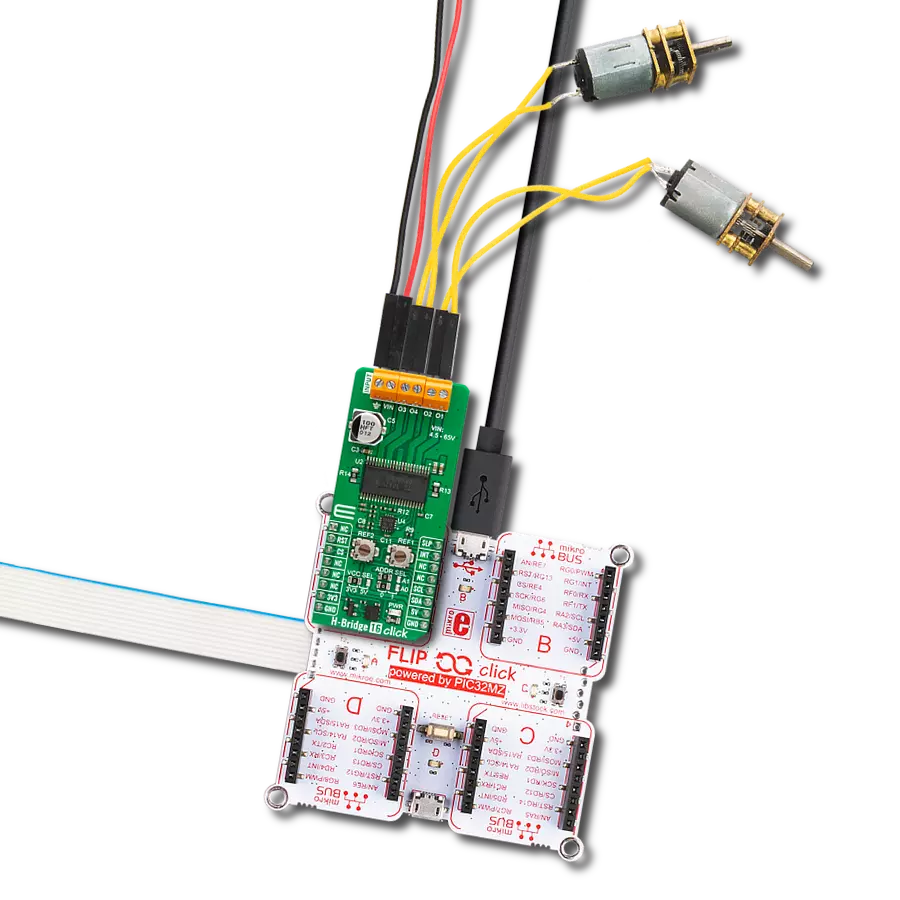Embrace the power of brushed motor control today and automagically regulate the current during the Start-up sequence of a DC motor!
A
A
Hardware Overview
How does it work?
DC Motor 15 Click is based on the DRV8874, an integrated motor driver with N-channel H-bridge, charge pump, current sensing and proportional output, current regulation, and protection circuitry from Texas Instruments. The DRV8874 operates from the external power supply from 4.5V to 37V, providing a wide range of output load currents for various motors and loads. The charge pump feature improves efficiency by supporting N-channel MOSFET half-bridges and 100% duty cycle driving. This Click board™ also integrates current sensing, regulation, and feedback. These features allow the DRV8874 to sense the output current without an external sense resistor or sense circuitry reducing system cost and complexity. This also allows the device to limit the output current in the case of the motor stall or high torque events and give detailed feedback to the MCU about the load
current through a proportional output on the AN pin of the mikroBUS™, labeled as IPR. The DRV8874 integrates an H-bridge output power stage that can be operated in different control modes by the PMODE pin setting. The PMODE pin on this Click board™ is set to a logic low level, meaning the device is latched into PH/EN mode. PH/EN mode allows the H-bridge to be controlled with a speed and direction type of interface through two GPIO pins labeled IN2 and IN1, routed to the PWM and CS pins of the mikroBUS™ socket. It also has a Sleep Mode that achieves ultra-low quiescent current draw by shutting down most of the internal circuitry. The SLP pin routed to the RST pin of the mikroBUS™ socket provides an ultra-low power mode to minimize current draw during system inactivity. As mentioned in the product description, DC Motor 15 Click communicates with MCU using several GPIO pins.
In addition to the pins used to adjust the speed and rotation direction of the motor, this Click board™ also has an interrupt labeled as FLT routed to the INT pin of the mikroBUS™ socket used to protect the device and the output load. The DRV8874 enters Fault Mode when a fault is encountered, leaves Fault Mode, and re-enters Active Mode when the recovery condition is met. This Click board™ can operate with either 3.3V or 5V logic voltage levels selected via the VCC SEL jumper. This way, both 3.3V and 5V capable MCUs can use the communication lines properly. However, the Click board™ comes equipped with a library containing easy-to-use functions and an example code that can be used, as a reference, for further development.
Features overview
Development board
Arduino UNO is a versatile microcontroller board built around the ATmega328P chip. It offers extensive connectivity options for various projects, featuring 14 digital input/output pins, six of which are PWM-capable, along with six analog inputs. Its core components include a 16MHz ceramic resonator, a USB connection, a power jack, an
ICSP header, and a reset button, providing everything necessary to power and program the board. The Uno is ready to go, whether connected to a computer via USB or powered by an AC-to-DC adapter or battery. As the first USB Arduino board, it serves as the benchmark for the Arduino platform, with "Uno" symbolizing its status as the
first in a series. This name choice, meaning "one" in Italian, commemorates the launch of Arduino Software (IDE) 1.0. Initially introduced alongside version 1.0 of the Arduino Software (IDE), the Uno has since become the foundational model for subsequent Arduino releases, embodying the platform's evolution.
Microcontroller Overview
MCU Card / MCU
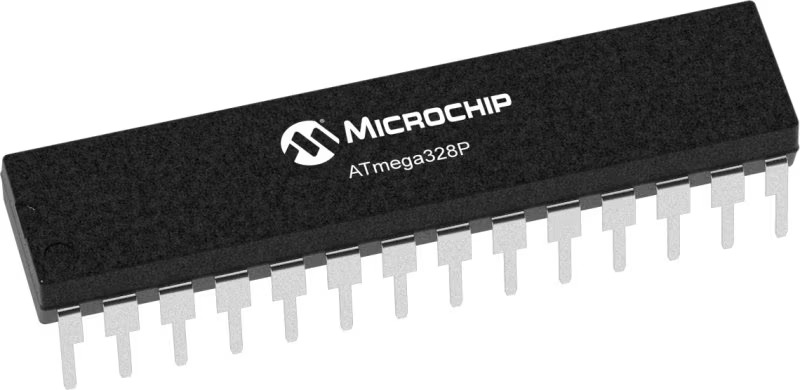
Architecture
AVR
MCU Memory (KB)
32
Silicon Vendor
Microchip
Pin count
28
RAM (Bytes)
2048
You complete me!
Accessories
Click Shield for Arduino UNO has two proprietary mikroBUS™ sockets, allowing all the Click board™ devices to be interfaced with the Arduino UNO board without effort. The Arduino Uno, a microcontroller board based on the ATmega328P, provides an affordable and flexible way for users to try out new concepts and build prototypes with the ATmega328P microcontroller from various combinations of performance, power consumption, and features. The Arduino Uno has 14 digital input/output pins (of which six can be used as PWM outputs), six analog inputs, a 16 MHz ceramic resonator (CSTCE16M0V53-R0), a USB connection, a power jack, an ICSP header, and reset button. Most of the ATmega328P microcontroller pins are brought to the IO pins on the left and right edge of the board, which are then connected to two existing mikroBUS™ sockets. This Click Shield also has several switches that perform functions such as selecting the logic levels of analog signals on mikroBUS™ sockets and selecting logic voltage levels of the mikroBUS™ sockets themselves. Besides, the user is offered the possibility of using any Click board™ with the help of existing bidirectional level-shifting voltage translators, regardless of whether the Click board™ operates at a 3.3V or 5V logic voltage level. Once you connect the Arduino UNO board with our Click Shield for Arduino UNO, you can access hundreds of Click boards™, working with 3.3V or 5V logic voltage levels.
DC Gear Motor - 430RPM (3-6V) represents an all-in-one combination of a motor and gearbox, where the addition of gear leads to a reduction of motor speed while increasing the torque output. This gear motor has a spur gearbox, making it a highly reliable solution for applications with lower torque and speed requirements. The most critical parameters for gear motors are speed, torque, and efficiency, which are, in this case, 520RPM with no load and 430RPM at maximum efficiency, alongside a current of 60mA and a torque of 50g.cm. Rated for a 3-6V operational voltage range and clockwise/counterclockwise rotation direction, this motor represents an excellent solution for many functions initially performed by brushed DC motors in robotics, medical equipment, electric door locks, and much more.
Used MCU Pins
mikroBUS™ mapper
Take a closer look
Click board™ Schematic

Step by step
Project assembly
Software Support
Library Description
This library contains API for DC Motor 15 Click driver.
Key functions:
void dcmotor15_forward ( );- Function is used to drive the motor forward.void dcmotor15_reverse ( );- Function is used to drive the motor in reverse.void dcmotor15_brake ( );- Function is used to brake the motor.
Open Source
Code example
The complete application code and a ready-to-use project are available through the NECTO Studio Package Manager for direct installation in the NECTO Studio. The application code can also be found on the MIKROE GitHub account.
/*!
* @file main.c
* @brief DC Motor 15 Click Example.
*
* # Description
* This example demonstrates the use of DC Motor 15 Click board.
*
* The demo application is composed of two sections :
*
* ## Application Init
* Initializes the driver and makes an initial log.
*
* ## Application Task
* Drives the motor in the forward direction for 5 seconds, then pulls brake for 2 seconds,
* and after that drives it in the reverse direction for 5 seconds, and finally,
* disconnects the motor for 2 seconds. It will also calculates and displays the motor current consumption.
* Each step will be logged on the USB UART where you can track the program flow.
*
* @author Stefan Filipovic
*
*/
#include "board.h"
#include "log.h"
#include "dcmotor15.h"
// Number of ADC conversions that will be performed for a single current measurement.
#define NUM_OF_ADC_CONVERSATIONS 1000
// Time period for forward and reverse modes in seconds.
#define RUN_PERIOD 6
// Time period for brake and stop modes in seconds.
#define IDLE_PERIOD 3
static dcmotor15_t dcmotor15; /**< DC Motor 15 Click driver object. */
static log_t logger; /**< Logger object. */
void display_current ( dcmotor15_t *ctx, uint16_t delay )
{
float current = 0;
for ( uint8_t cnt = 0; cnt < delay; cnt++ )
{
Delay_ms ( 1000 );
current = dcmotor15_get_current ( &dcmotor15, NUM_OF_ADC_CONVERSATIONS );
log_printf( &logger, " Current : %.3f [A]\r\n", current );
}
log_printf( &logger, " ------------------------------\r\n" );
}
void application_init ( void )
{
log_cfg_t log_cfg; /**< Logger config object. */
dcmotor15_cfg_t dcmotor15_cfg; /**< Click config object. */
/**
* Logger initialization.
* Default baud rate: 115200
* Default log level: LOG_LEVEL_DEBUG
* @note If USB_UART_RX and USB_UART_TX
* are defined as HAL_PIN_NC, you will
* need to define them manually for log to work.
* See @b LOG_MAP_USB_UART macro definition for detailed explanation.
*/
LOG_MAP_USB_UART( log_cfg );
log_init( &logger, &log_cfg );
Delay_ms ( 100 );
log_info( &logger, " Application Init " );
// Click initialization.
dcmotor15_cfg_setup( &dcmotor15_cfg );
DCMOTOR15_MAP_MIKROBUS( dcmotor15_cfg, MIKROBUS_1 );
if ( ADC_ERROR == dcmotor15_init( &dcmotor15, &dcmotor15_cfg ) )
{
log_error( &logger, " Application Init Error. " );
log_info( &logger, " Please, run program again... " );
for ( ; ; );
}
dcmotor15_default_cfg ( &dcmotor15 );
log_info( &logger, " Application Task " );
}
void application_task ( void )
{
log_printf( &logger, " The motor turns forward! \r\n" );
dcmotor15_forward( &dcmotor15 );
display_current ( &dcmotor15, RUN_PERIOD );
log_printf( &logger, " Pull brake! \r\n" );
dcmotor15_brake( &dcmotor15 );
display_current ( &dcmotor15, IDLE_PERIOD );
log_printf( &logger, " The motor turns in reverse! \r\n" );
dcmotor15_reverse( &dcmotor15 );
display_current ( &dcmotor15, RUN_PERIOD );
log_printf( &logger, " The motor is disconnected (High-Z)! \r\n" );
dcmotor15_stop( &dcmotor15 );
display_current ( &dcmotor15, IDLE_PERIOD );
}
int main ( void )
{
/* Do not remove this line or clock might not be set correctly. */
#ifdef PREINIT_SUPPORTED
preinit();
#endif
application_init( );
for ( ; ; )
{
application_task( );
}
return 0;
}
// ------------------------------------------------------------------------ END
Additional Support
Resources
Category:Brushed





















